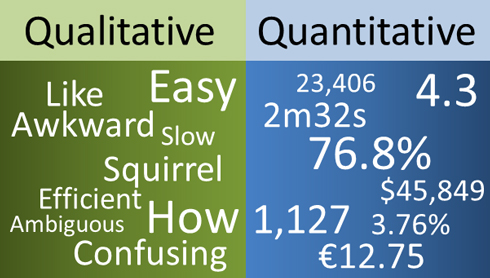
The culmination of a Master’s degree is the final project. Also known as a dissertation, or thesis, it may be entirely theoretical in nature, being based on secondary readings, or it may be a mix of theory and practice, whereby some aspect of theory is tested in a real-life situation. The project itself seeks to answer, previously unanswered questions, within a specific area of study. And there are two main methods by which the answers to these questions may be interpreted:
Qualitative and Quantitative Methods
Quantitative and qualitative research are processes which collect data from individuals and groups to be analysed and interpreted. Quantitative research is concerned with an objective reality stated as numbers, statistics or frequency. This research process is linear, in that it applies a specific research question to a sample, in order to collect data, analyse the results and draw conclusions. According to Brown (2011), quantitative research includes: descriptive, exploratory, quasi-experimental, and experimental. Thus, as their names indicate, such methods inform questions that seek descriptive, predictive, explanatory, or evaluative answers, e.g.
How many males get a first-class degree compared to females?
What percentage of teachers and school leaders belong to ethnic minority groups?
(Muijs, 2004)
By contrast, qualitative research takes a more subjective approach, focusing on the interpretations of individuals about the world around them. This makes the qualitative research process more cyclical, in that it applies a broad research question to a data sample. The four major qualitative approaches to collecting data are ethnography, phenomenology, field research and Grounded Theory (Glaser and Strauss, (1965) cited in Bell (2010)). Each approach, while distinct, “…focuses on questions that examine the relationships between information about people’s actions and phenomena, and the settings in which they do these things” (Freeman, 2009). Indeed, Grounded theory is an iterative process, developed around a phenomena of interest, where the theory is grounded in observation. This example confirms Freeman’s (2009) assertion that what makes a study qualitative is not the method, nor the questions but the relationship between dynamic relationship between the research setting, questions, claims and warrants.

However, the boundaries between quantitative and qualitative are not always set in stone. For example, qualitative strategies may be used to answer exploratory questions as they help identify salient features of new phenomena which may require further probing. For example, Bloom’s 2007 exploratory study (Bloom (2007), cited in Ellis (2010)) in which she sets out to investigate the experiences of herself and her students, and switches to examining the sources of tension in the classroom. Qualitative approaches may also used to answer descriptive questions because they can provide extensive information about situations. For example, Lyster and Ranta’s 1997 study of corrective feedback (Lyster & Ranta (1997), cited in Ellis (2010)).
Research study may simultaneously attempt to address different questions, all with different purposes. Therefore, multiple methods may be used to “triangulate” the validity of the research data. For example, Morita (Morita (2002), cited in Morita, 2012) executed mixed methods over an academic year to ground her data on the situated construction of identity and positionality in multilingual classrooms. This is particularly useful when wanting to validate and confirm the reliability of your work.
Quite simply, the strength of one method, is the weakness of the other. Qualitative research provides a deep understanding of a particular topic through rich, multi-perspective descriptions. As such it is very detailed. However, qualitative research reveals neither frequency, nor definitive strength of association. Longitudinal, qualitative studies may be quite time-consuming, and thus may have an associated high cost. On the other hand, quantitative research is useful in that it may be easier to generalise trends, whereas qualitative data may contain so much detail it may be difficult to generally interpret results. Finally, there are limitations to qualitative research in that an emphasis on direct observation, may compromise the validity of the experiment, if the researcher is seen as being intrusive.
In summary, understanding the relatives merits and limitations of quantitative and qualitative research will help researchers make appropriate methodological choices for their work. And the hope is that this newly acquired knowledge will help me as I start work on my own Master’s dissertation project.
References
Bell (2010). Doing Your Research Project: A Guide for First-time Researchers in Education, Health and Social Science. Maidenhead: Open University Press, Ch 13.
Bloom, at al. (2006). Developing a course to teach Spanish for health care professionals. Journal of Nursing Education, 45, 7:271-274. Cited in Ellis, R. (2012). Methods for Researching the Second Language Classroom, Language Teaching Research and Pedagogy. John Wily & Sons, Ch 12.
Brown, J.D. (2011). Quantitative Research in Second Language Studies. In: E. Hinkel (Ed.), Handbook of Research in Second Language Teaching and Learning, Volume 2, New York: Routledge, pp 190-206
Freeman, D. (2009) What Makes Research ‘Qualitative’?, In: J. Heigham & A. Croker (Ed.), Qualitative Research in Applied Linguistics, Ch 2, pp25 – 41
Glaser, B. & Strauss, A. (1965) Awareness of Dying. Chicago: Aldine Publishing Company. Cited in Bell, Judith. (2010) Doing Your Research Project (5th Edition): McGraw-Hill Education, p29.
Lyster, R. & Ranta, L. (1997). Corrective feedback and learner uptake: Negotiation of form in communicative classrooms. Studies in Second Language Acquisition, 19, 37-66. Cited in Ellis, R. (2012). Methods for Researching the Second Language Classroom, Language Teaching Research & Pedagogy. John Wilet & Sons, Ch 12.
Muijis, D. (2011). Doing quantitative research in education with SPSS. Los Angeles, Sage Publications.
Morita, N. (2002). Negotiating participation in second language academic communities: A study of identity, agency, and transformation. Unpublished doctoral dissertation. University of British Columbia. Cited in Morita, N. (2012). Identity: The Situated Construction of Identity and Positionality in Multilingual Classrooms. In: Mercer, Ryan & Williams (Ed.) Psychology for language learning: insights from research, theory and practice, Ch3, pp26-41
Image 1: qq.jpg/ http://www.alignedinsuranceinc.com/claim/
Image 2: qual_quant.jpg/ http://evaluation-essay.weebly.com/blog/dissertation-quantitative-analysis-v-qualitative-analysis
